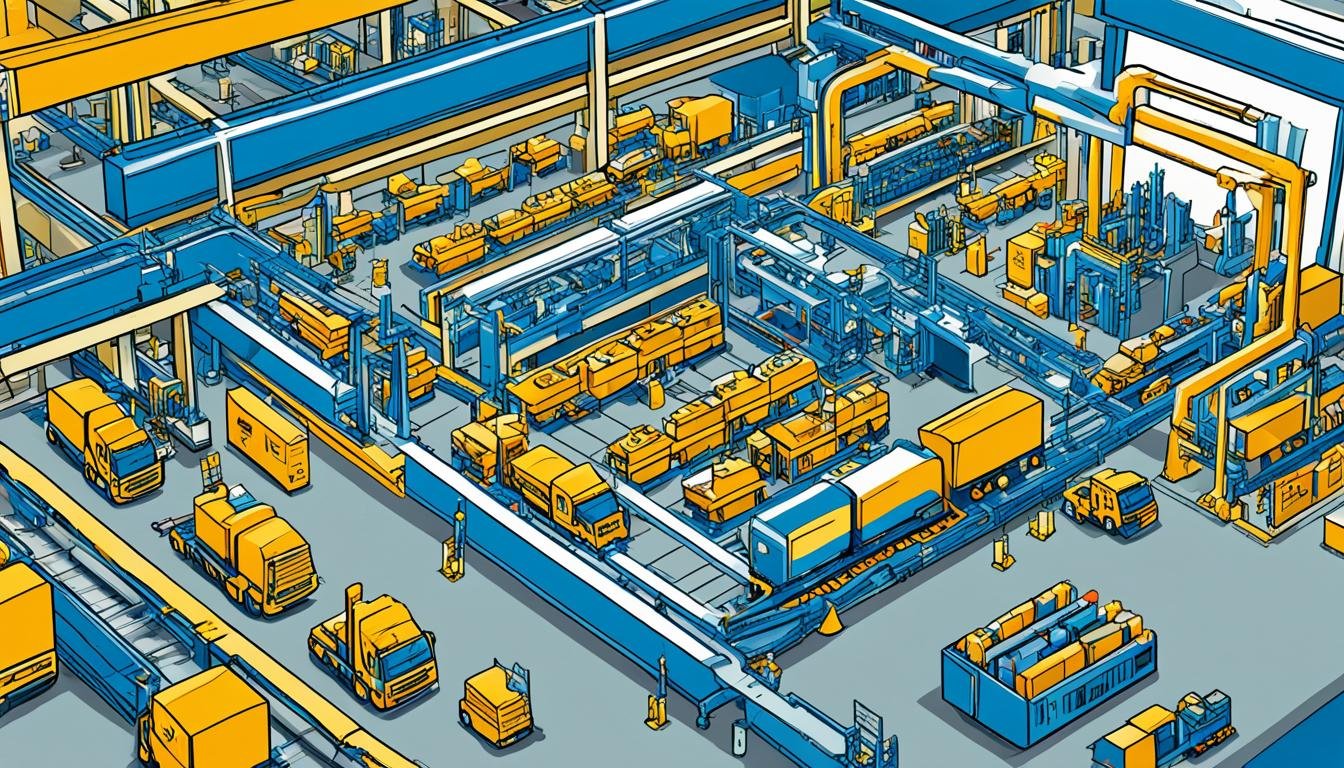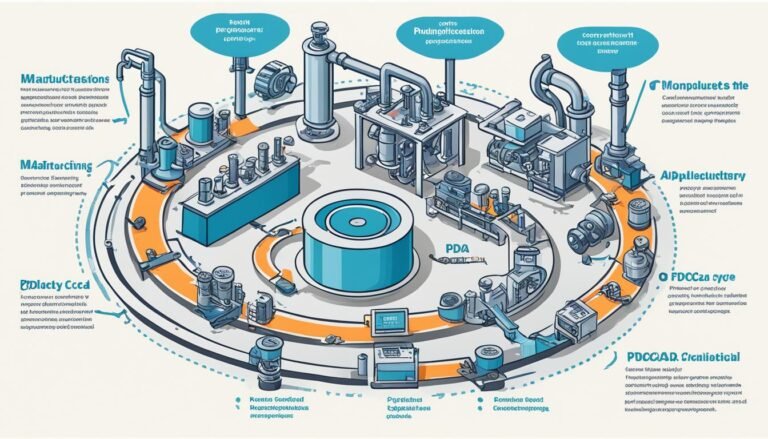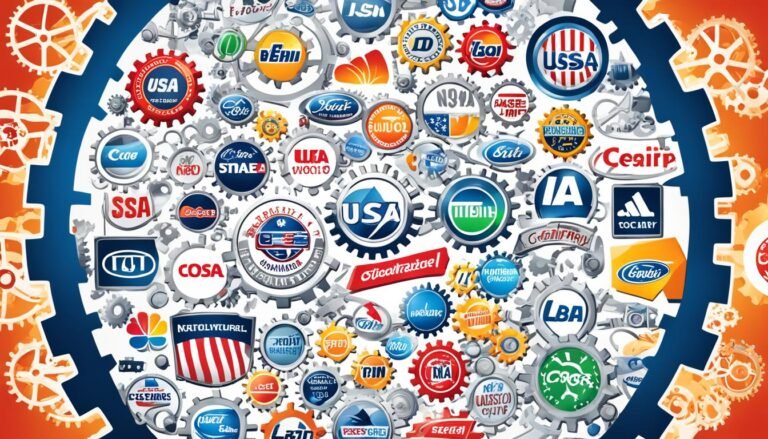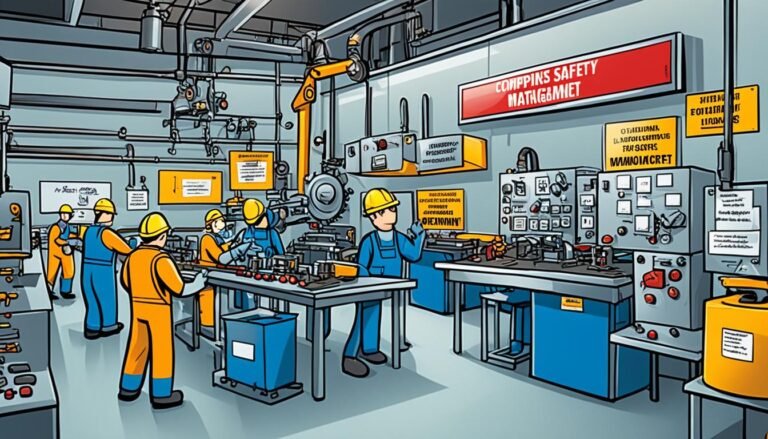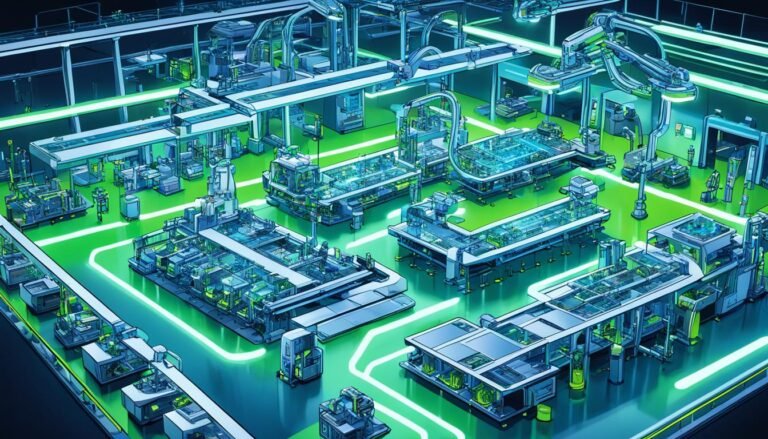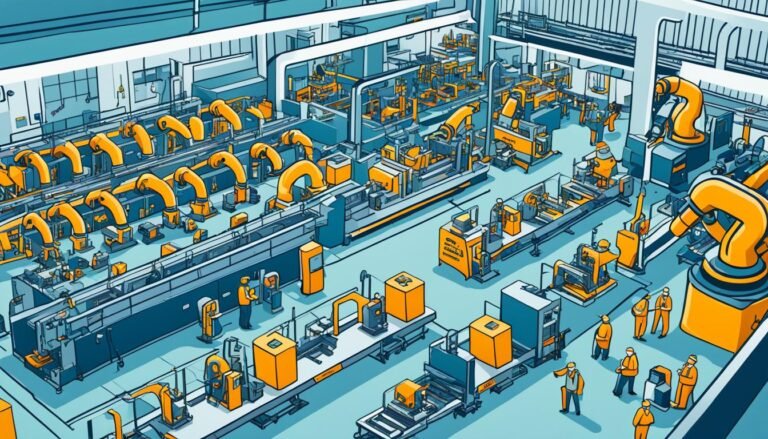Introduction to Supply Chain Management in Manufacturing
Did you know that inventory turnover is a key measure of supply chain success? It’s found by dividing the cost of goods sold by the average inventory value. This shows how important managing inventory well is in supply chain management (SCM).
For manufacturing, SCM is crucial. It’s not just a behind-the-scenes task. It’s a key system that boosts business operations and helps companies stand out in the global market.
SCM manages the whole journey of goods, from raw materials to the customer. It involves logistics, procurement, and making manufacturing more efficient. Companies like Dell, Toyota, and Amazon use SCM to run smoothly and meet customer needs.
Today, using tools like ProjectManager can make SCM better. It helps improve customer value and make supply networks more efficient. As we explore SCM more, it’s clear that mastering it can greatly improve manufacturing’s sustainability and performance.
Key Takeaways
- Inventory turnover is a key measure of supply chain performance.
- Days of supply is critical for maintaining optimal inventory levels.
- SCM includes numerous links such as suppliers, manufacturers, and distributors.
- Effective SCM enhances manufacturing efficiency and competitiveness.
- Advanced platforms like ProjectManager modernize SCM processes.
- SCM involves managing the flow of materials, information, and finances.
Understanding Supply Chain Management in Manufacturing
Supply Chain Management (SCM) in manufacturing is all about linking key business processes from the customer to the suppliers. It adds value by providing products, services, and information. This makes customers and stakeholders happy.
Definition and Overview
SCM in business administration is about managing supply chains. It controls the flow of goods and services. It makes sure everything moves smoothly from getting raw materials to delivering finished products.
It covers several important steps: planning, sourcing, making products, delivering them, and handling returns. Each step is vital for efficiency in manufacturing and inventory management.
The Importance of SCM
SCM is more than just moving goods around. It’s a key strategy for staying ahead in the market. Companies like Walgreens Boots Alliance Inc. use advanced tech to improve their supply chain.
This includes managing data from over 20,000 suppliers and 9,000 stores. It helps them deliver products better and reduces risks from recalls and lawsuits.
Key Benefits of SCM in Manufacturing
Companies that use good SCM get many benefits:
- Enhanced Customer Satisfaction: They can meet customer needs better, avoiding stockouts or overstocking.
- Reduced Operating Costs: Better supply chain management cuts costs in production and distribution.
- Proactive Strategy Implementation: SCM lets companies plan ahead with data insights.
- Stimulated Innovation: It encourages teamwork and innovation, opening up new market chances.
SCM has a big impact on business, with supply chain jobs paying well. Roles in SCM offer salaries between $111,000 and $142,000 a year. This attracts more professionals, leading to better efficiency in manufacturing and inventory management systems.
The Components of a Supply Chain
The supply chain has many key parts that make it work well. Knowing these parts is key for a smooth flow from raw materials to finished products.
Suppliers and Raw Materials
Suppliers are the heart of the supply chain, giving the raw materials needed for making products. Companies must find a balance between quality and cost to meet customer needs and stay profitable. A strong supply chain needs steady and on-time deliveries from suppliers.
A supply chain that’s too weak can face big problems, like the 72% disruption rate seen during the COVID-19 pandemic. Choosing reliable and varied suppliers helps avoid the dangers of relying too much on one supplier.
Manufacturing Process
The manufacturing process is a big part of the supply chain and key to making products of high quality and on time. It needs good production management and a focus on quality. Companies aim to make their manufacturing supply chains better to produce quality goods efficiently.
This step changes raw materials into final products. It also needs coordination with other supply chain steps to match demand accurately.
Distribution Channels
After making products, they need to be stored and moved through distribution channels to get to customers or stores. Distribution channels cover all the physical moves of goods, inside a company or to the end customer. A good distribution strategy means products get to customers fast and at a lower cost.
Logistics is key in managing and moving goods. This shows how important a strong distribution strategy is.
Customer Relations
Customer relations are vital at the end of the supply chain. Keeping strong ties with customers through good communication and reliable service keeps them happy and loyal. Companies use demand forecasting to guess what customers will want, cutting down on overproduction or stockouts.
By giving great customer experiences and listening to feedback, businesses can stay ahead in the market.
Exploring Modern Techniques in SCM for Manufacturing
Manufacturing is changing, and so are the ways we manage supply chains. Now, SCM uses advanced methods like lean manufacturing and automation. Tools like ERP systems, AI, and IoT make supply chains more flexible and responsive to market changes and customer needs.
Lean manufacturing is a key strategy in SCM today. It focuses on cutting waste and improving processes for better efficiency and quality. By combining lean with advanced technologies, companies can cut down on time and costs, and make better products.
Now, we’re seeing new ways to manage supply chains. Dynamic sourcing aims to improve the whole process of getting materials. With advanced tech, we can track and analyze data in real-time. This gives us better control over the supply chain and helps make smart choices.
Building strong relationships with suppliers is also key in SCM. These partnerships help ensure a steady supply of materials. Companies are now investing in tech to improve these relationships and keep production on track.
With IoT and AI, we can now monitor the supply chain in real-time. This means we can make quicker decisions and adapt to changes faster. A connected supply chain leads to better performance, happier customers, and more sustainable practices.
| SCM Model | Key Focus | Benefits |
|---|---|---|
| Continuous Flow | Steady production with little variation | Consistency, reduced lead times |
| Fast Chain | Quick production for trendy products | Faster market response |
| Efficient Chain | Maximized efficiency and cost control | Lower costs, higher margins |
| Flexible Model | Adaptability to market changes | Improved capability to handle demand fluctuations |
Using modern SCM techniques and building strong supplier relationships is key to staying ahead in manufacturing. These strategies help companies meet and beat customer expectations. They ensure growth and success in a fast-changing market.
The Five Phases of Supply Chain Management
Mastering supply chain management is key for making manufacturing successful. It’s divided into five main parts: planning, sourcing, manufacturing, delivery, and returns. Each part is vital for smooth operations, making production better, and keeping customers happy. Let’s look at what each phase involves.
Planning
Supply chain planning starts by predicting what customers will need and matching supply with demand. Using real-time data and unified planning helps companies guess customer needs better. Good planning lets supply chains adjust to changes easily, making them more flexible and less prone to problems.
Sourcing
In the sourcing phase, companies pick reliable suppliers and create strong strategies for getting materials on time and in good quality. Working closely with suppliers helps ensure materials are always available and boosts production efficiency. Good sourcing is crucial for a steady supply of quality raw materials.
Manufacturing
The manufacturing phase turns raw materials into finished products. It focuses on making production more efficient, which can be done with new technologies and methods. Better production efficiency means products are of higher quality, and there are fewer problems, making the delivery stage smoother.
Delivery
The delivery phase makes sure products get to customers quickly and safely. It involves choosing the right logistics partners and finding the best routes for transport. Good delivery plans are key for keeping customers happy and meeting their needs fast.
Returns
The returns phase, or return logistics, deals with customer support after a sale. Handling returns well is important for keeping a good brand image and customer loyalty. This includes taking back products, giving refunds, and managing returned items, aiming for a positive experience for customers.
By carefully managing these five phases—planning, sourcing, making products, delivering, and returns—manufacturers can make their supply chain work better. This leads to more productivity and profits.
Effective Strategies for Supply Chain Management
In today’s fast-paced business world, having solid SCM strategies is key. These strategies help companies add value from start to finish. They cover everything from working with suppliers to making customers happy. This ensures SCM optimization, operational efficiency, and cost reduction.
Creating strong relationships with suppliers is vital. By building solid partnerships, companies get a steady supply of materials. This reduces risks and delays. After COVID-19, many retailers changed how they work with suppliers. They now use multiple suppliers to lower risks.
Good demand management is also crucial. Using past sales and analytics helps predict what customers will want. This helps companies plan better, use resources wisely, and avoid making too much or too little. It cuts costs and makes customers happier.
Optimizing how orders are fulfilled keeps the supply chain running smoothly. New software and tools help manage stock, adjust prices, and boost operational efficiency. AI and machine learning are becoming common. They give deeper insights and help improve supply chain operations.
Using advanced risk management models like the PPRR model is also important. It helps companies prepare for and handle risks. This makes them more resilient when things go wrong.
Good SCM strategies make operations smoother and add value at every step. They combine tech, data analysis, and strong partnerships. The goal is to improve SCM optimization, cost reduction, and operational efficiency.
Conclusion
Supply chain management (SCM) is key to the success of the manufacturing industry. It brings many benefits like making companies more competitive, making customers happier, and cutting costs. By focusing on managing inventory, finding the best sources, running facilities well, moving goods, sharing information, and setting prices, companies can grow and make more money.
The way SCM has changed shows how important it is to keep up with new technology and focus on being green. Green Supply Chain Integration (GSCI) helps make supply chains more sustainable. Things like how goods are moved, the flow of information, and pricing can make a big difference. In places like Pakistan’s textile and automotive sectors, using green practices like recycling and just-in-time inventory helps meet sustainability goals.
Manufacturing companies should adopt these new strategies for long-term success. Good SCM means always working to make the supply chain better. Whether it’s for steady or changing demands, the goal is to predict and meet needs well. By using strategic SCM, companies can reduce their environmental impact, make logistics smoother, and turn filling orders into a big way to make money. This ensures success and a sustainable future in manufacturing.
Source Links
- Supply Chain
- PRDV304: Introduction to Supply Chain Management | Saylor Academy
- Introduction to Supply Chain Management – GeeksforGeeks
- Supply Chain Management (SCM): How It Works & Why It’s Important
- An Introduction to Supply Chain Management (SCM)
- What Is Supply Chain Management? | IBM
- Understanding Global Manufacturing Supply Chains
- The Supply Chain: From Raw Materials to Order Fulfillment
- What is the supply chain for manufacturing? — Method
- Supply Chain Management Strategies in the Manufacturing Industry
- Managing the Manufacturing Supply Chain
- What is Supply Chain Management and the SCM Process | Anaplan
- A Guide to the Supply Chain Process
- Supply Chain Management: Meaning, Process, Types, Importance & Working Method | GEP Blog
- Supply Chain Risk Management: 10 Strategies for Success – Hitachi Solutions
- Guide to Supply Chain Management
- Strategic Supply Chain Management: Develop & Plan Supply Chain Strategy | GEP Blog
- Supply Chain Management Case Study: Conclusion & Recommendations | Saylor Academy
- What is Supply Chain Management? SCM Definition & Examples

